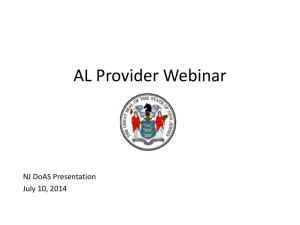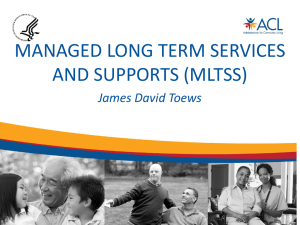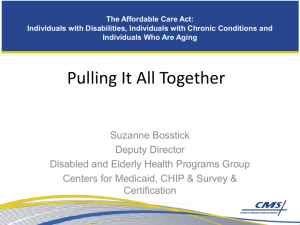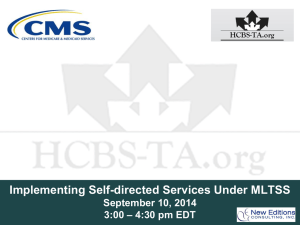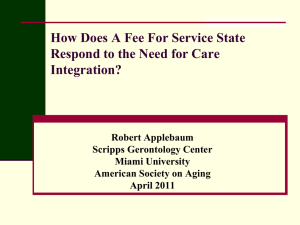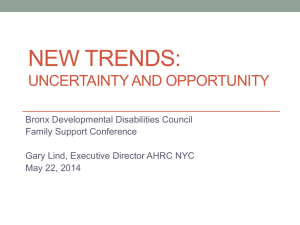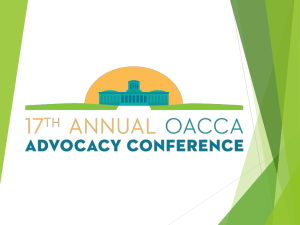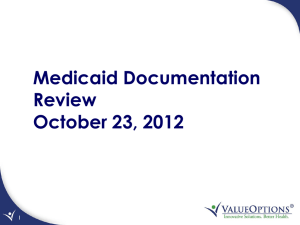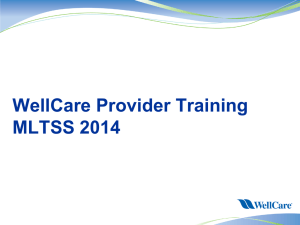A national perspective on services and supports for people with
advertisement
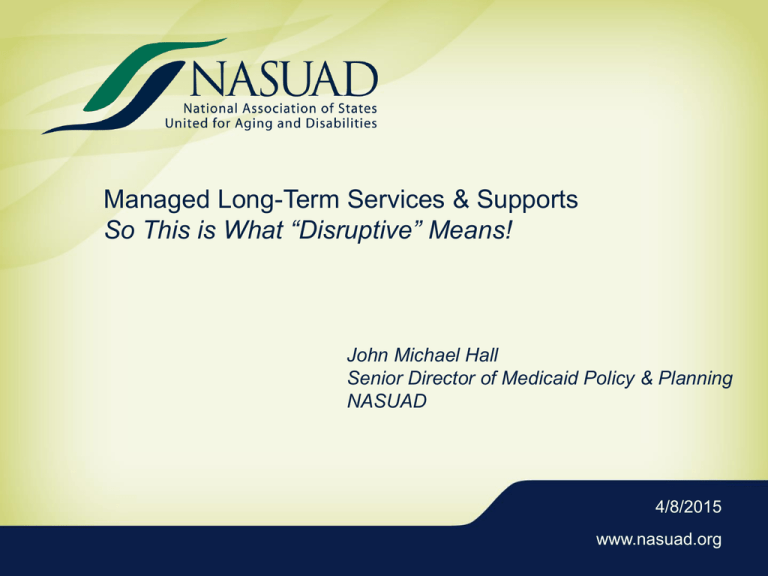
Managed Long-Term Services & Supports So This is What “Disruptive” Means! John Michael Hall Senior Director of Medicaid Policy & Planning NASUAD 4/8/2015 www.nasuad.org What’s Happening? Dramatic shift in State Medicaid programs away from Fee- for-Service towards Managed Care (and other bundled payment / outcome driven delivery models) In 2010, roughly 72% of Medicaid beneficiaries nationally were served in managed care / PCCM programs But managed care accounted for only 30% of Medicaid spending. Why? Most managed care enrollees are younger adults & children (think TANF & CHIP). Elderly and disabled populations – the most costly – are carved-out and remain in FFS 1915(c) waivers 2011 & 2012 saw huge increase in States signaling that they would move their Medicaid programs to managed care Page 2 What’s Happening? (cont’d) In several cases – Kentucky, Louisiana, New Hampshire – negligible MC penetration, now adopting MC statewide In several other cases, States with experience in MC, concentrated in urban areas – New York, Texas, California – announced they will expand MC statewide to cover all their Medicaid beneficiaries – millions of beneficiaries “Within two years, we do not expect to have any significant FFS presence in our Medicaid program.” quote from Medicaid director of large State And what else is happening? Most of these States are also proposing to migrate their carved-out 1915(c) populations into MLTSS Would not be surprising if MC market share in Medicaid increases to 90% (or higher) by 2015, with MC accounting for 50+% (or greater) share of Medicaid spend nationally Why? It’s Where the Money Is: + Elderly & Disabled (DD/PD) = 34% of Medicaid lives 68% of Medicaid spending MLTSS States Expand the Managed Care Footprint 9 of 16 States with existing MLTSS programs announced plans to expand (Red) 5 New States Join the Fray At least 11 additional/new (Green) States have announced plans to migrate LTC populations to MLTSS (or have already done so!) Why now? Why so fast? • State budget deficits – collective deficits of $175 billion through 2013, on top of the $230 billion in budget gaps states filled between fiscal years 2009 and 2011. • Total Medicaid spending increased by 7.9% in FY10 and11.2 % in FY11 • Long-term care spending trends are unsustainable – even before we start focusing on the baby boomer demographic • ACA emphasis on care coordination / integration, corralling chronic disease • MMCO / Duals Office Financial Alignment Initiative • 2014 Medicaid expansion -- 17 million new beneficiaries Why now? Why so fast? (cont’d) • New State leadership – 29 new Governors, most in history • The 80/20 rule and cost of chronic disease – the most popular pie chart in health care • Fiscal implications of continuing to ignore cost of chronic illness • “Never let a good crisis go to waste” • “If not now when . . .” Coordinated & Integrated Care • Shift to MC part of a larger trend toward Integrated / Coordinated Care, including PCCM, Health Homes, ACOs, bundled payment strategies • Recognition that we have done a poor job of addressing chronic disease . . . and an even poorer job of integrating physical / acute care with long-term care (see 2001 IOM report: Crossing the Quality Chasm) • Medicaid-funded LTC delivery systems and §1915(c) home- & community-based (HCBS) waivers are almost completely estranged from the physical / acute delivery systems • Federal / state funding for HCBS emphasized / measured / paid for deinstitutionalization, rebalancing, independent living, Olmstead compliance, participant-directed care • . . . but not health status / outcomes Paying for Outcomes, Instead of Volume • Shift to MC and MLTSS delivery systems is also driven – at least in part – by realization that unit-based FFS delivery system has failed, and is . . . • not keeping people healthy, or helping them get better • not fulfilling promise of rebalancing • not sustaining expansion of independent living / home-& community-based alternatives to institutional care (nursing homes, ICF/MRs, IMDs) • Disturbingly, not really person-centered • * * * Extremely difficult to be integrated in the community, to live with independence & dignity -- if you’re not healthy * * * • Living alone and socially isolated on the couch or in front of the TV . . . not what we originally had in mind. • Recognition that we must realign reimbursement incentives and introduce accountability for outcomes & quality improvement, “experience of care”, quality of life What Does All This Mean for the HCBS System? • First, the world, as we know it, is drastically changing • HCBS system of the last two decades was vertically-integrated In many / most states, HCBS providers simultaneously served as: 1. The gateway, conducting functional need assessments 2. Information & referral resource 3. Care/service plan development entity 4. Case manager / service coordinator 5. Service provider • Often enjoyed sole-source geographic monopolies and virtually guaranteed revenue streams • Riddled with conflict-of-interest, driving business to their own doors, cutting out competitors, building caseload & utilization • FFS HCBS has become big business, even for “non-profits”, even for organizations that started with a social mission • Let’s be honest: in far too many cases, loudest concerns about MLTSS have been more about preserving FFS providers’ revenue streams’ than interests of consumers MLTSS: Disrupting the HCBS Market Introduction of MLTSS breaks up vertical integration: Not clear that HCBS providers will retain the assessment function. Best case: standardized assessment tool & independent assessment entity (State or contractor via RFP) Providers seeking to compete for assessment contracts will need to be conflict-free – choose which business they want to be in Care / service plans will be developed by the MCOs In most cases, service coordination / care management of LTC services will reside with MCO, not AAAs / CILs Huge impact for HCBS providers, since lions’ share of revenue came from these three functions Opportunities for Providers • States not necessarily interested in paying MCOs to build – from scratch – MLTSS delivery system / infrastructure / expertise that States’ have spent last two decades building and paying for • MCOs are not especially interested in replicating these services, either • MCOs understand they can fast-track their own competency by purchasing this expertise from existing providers Challenges for Providers • Not all providers will (or should) survive • Expect unprecedented numbers of agency failures / closures, mergers & consolidations • In many states, there are just too many HCBS providers. Several states are moving to combine service regions and reduce # of agencies • MCOs are not interested in contracting with a multiplicity of small agencies. • “One Throat to Choke” . . .or at most “a few throats” • Volume / economies of scale will matter • The loss of sole source revenue streams and shift to competitive market environment will separate the weak from the strong, the high performers from the poor performers. “Survival of the fittest” • Should States require MCOs to contract with poor-performing agencies? What Does the New World Look Like? • Providers must reassess their business models and take a hard look at how they’re staffed and where their costs are • Rapidly adjust their thinking to competitive, market-based frame of reference, not sole-source monopoly. They will not get selected just because they exist. • Providers will have to compete (in State procurements) and against other providers for a share of the MLTSS business. • Goal: to be regarded as high-quality, high-value preferred vendor. • Their products and services must be “market grade”. • Need to understand and align their service / products with MCOs’ interests: “If you can’t improve outcomes and assist MCO in staying under the capitation, you’re not a viable player.” • Providers must be conflict-free – they will have to choose which lines of business to retain • Absolutely essential to accurately (& competitively) price services Policy Implications of MLTSS Expansion • Concern that MCOs may have expertise in Medicaid physical / acute care world, but are unfamiliar / uncomfortable with LTSS and, especially, ID/DD services • Will MCOs demonstrate literacy / competency in serving MLTSS special needs populations: elderly, intellectually /developmentally & physically disabled, TBI, etc? • Will core principles of HCBS, independent living, consumer control, persondriven decision-making be preserved . . . ENHANCED? • Will MLTSS advance cause of rebalancing & deinstitutionalization? Hint: Reliance on group homes not a desirable goal. • MCOs are just as susceptible to conflict-of-interest as FFS providers . . . and will economically abuse the system to advantage themselves when given the chance . . . just as FFS providers have (http://www.nytimes.com/2013/04/23/nyregion/day-centers-lure-fit-eldersand-bill-medicaid.html?hp) Measuring & Optimizing Outcomes in MLTSS • How will we measure outcomes in MLTSS? (Emphasis on outcomes, not units) • Clinical / health outcomes are the easy part • Challenge will be measuring the non-clinical aspects of HCBS: independence self-determination integration Dignity • We don’t have much in the way of MLTSS outcomes . . . partly because we never really had any FFS outcome measures (other than volume / frequency) • Truthfully, measuring outcomes (experience of care, attainment of professed policy objectives, value for the taxpayers’ money) was never a priority for either CMS or the States • So, it’s about time we started getting serious: What does our money buy? Are peoples’ lives improved? How does it feel to be on the receiving end of care / services? Measuring & Optimizing Outcomes in MLTSS (cont’d) • It starts with the Terms of Engagement: RFP Contract requirements Monitoring & oversight . . . and Reimbursement • Driving MCO behavior with performance measures & reimbursement conditioned on benchmark achievement • Never, ever forget these three maxims: People (and organizations) will do exactly what you pay them to do (including: if you pay them for volume, you’ll get volume) If you don’t pay them to do it, they won’t You get the behavior that you measure • States need to be serious about appropriately staffing oversight & monitoring. This is a terrible place to take savings. MLTSS is a Watershed • The most significant development in LTC since Katie Beckett and the creation of the 1915(c) HCBS waivers • The HCBS paradigm shift: discarding the assumption that elders and people with disabilities should be shut away in institutions • We have learned a lot in the last 30 years. Now we must figure out what to keep (the best of HCBS) . . . in the context of a new paradigm: HCBS must be relentlessly person-driven, and the rhetoric of independence, integration & dignity means nothing if we fail to assure that people can “attain and maintain her highest practicable physical, mental, and psycho-social well-being.” • MLTSS is not a panacea, but done right MLTSS can advance our efforts to: focus on outcomes & quality of life eliminate conflict-of-interest expand opportunities to live independently in home- & community-based settings achieve true integration of seniors and people with disabilities in the fabric of society For more information, please visit: www.nasuad.org Or call us at: 202-898-2578

